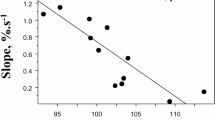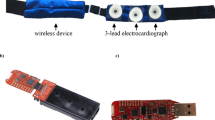Abstract
Background
Autonomic dysfunction is a key trait in the development of obstructive sleep apnea syndrome (OSAS) in adults. However, few similar studies focused on children and adolescents. We investigated if there was any association between heart rate recovery (HRR) and the severity of OSAS in children and adolescents.
Methods
A total of 161 subjects were included: 87 healthy controls, 35 mild OSAS patients (M-OSAS) and 39 moderate-severe OSAS (M-S-OSAS) patients. Clinical parameters, cardiopulmonary exercise test (CPET) indexes including HRR and polysomnographic records including apnea−hypopnea index (AHI) were compared among the three groups. Pearson correlation analysis and multivariable linear regression analysis were used to detect the relationship between HRR and polysomnographic parameters.
Results
HRR values in either the OSAS group were lower than those of the control group, and the values in the M-S OSAS group were even lower than those of the M-OSAS group (P < 0.05). Correlation analysis showed that HRR was inversely correlated with AHI (r = −0.190, P < 0.01). Moreover, multivariable linear regression analyses showed the association between HRR and AHI was significant (β = 0.174, P < 0.01).
Conclusions
HRR was closely associated with OSAS severity, which suggested that HRR might be a promising index for risk stratification and clinical management in children and adolescents with OSAS.
Impact
-
Heart rate recovery (HRR), a noninvasive and reliable index of automatic nervous system, is closely associated with the severity of obstructive sleep apnea syndrome (OSAS) in children and adolescents.
-
To our knowledge, our study was the first study in China focusing on evaluating the role of HRR in children with OSAS.
-
We found HRR was closely associated with OSAS severity in children and adolescents, and it suggested that HRR might be a promising index for risk stratification and clinical management in children and adolescents with OSAS.
Similar content being viewed by others
Log in or create a free account to read this content
Gain free access to this article, as well as selected content from this journal and more on nature.com
or
References
Joosten, K. F. et al. How do we recognize the child with OSAS? Pediatr. Pulmonol. 52, 260–271 (2017).
Li, A. M. et al. Epidemiology of obstructive sleep apnoea syndrome in Chinese children: a two-phase community study. Thorax 65, 991–997 (2010).
Blechner, M. & Williamson, A. A. Consequences of obstructive sleep apnea in children. Curr. Probl. Pediatr. Adolesc. Health Care 46, 19–26 (2016).
Walter, L. M. et al. Autonomic dysfunction in children with sleep disordered breathing. Sleep Breath. 17, 605–613 (2013).
Kheirandish-Gozal, L., Bhattacharjee, R. & Gozal, D. Autonomic alterations and endothelial dysfunction in pediatric obstructive sleep apnea. Sleep Med. 11, 714–720 (2010).
Torre-Bouscoulet, L. et al. Mechanisms of cardiovascular damage in obstructive sleep apnea. Rev. Invest. Clin. 60, 502–516 (2008).
Muzumdar, H. V. et al. Changes in heart rate variability after adenotonsillectomy in children with obstructive sleep apnea. Chest 139, 1050–1059 (2011).
El-Hamad, F. et al. Altered nocturnal cardiovascular control in children with sleep-disordered breathing. Sleep 1, 40 (2017).
Liu, X. et al. Effect of adenotonsillectomy for childhood obstructive sleep apnea on nocturnal heart rate patterns. Sleep 41, zsy171 (2018).
Qiu, S. et al. Heart rate recovery and risk of cardiovascular events and all-cause mortality: a meta-analysis of prospective cohort studies. J. Am. Heart Assoc. 6, e005505 (2017).
Bjelakovic, L. et al. Heart rate recovery time in metabolically healthy and metabolically unhealthy obese children. Phys. Sportsmed. 45, 438–442 (2017).
Alvarado, A. M. et al. Heart rate recovery is impaired after maximal exercise testing in children with sickle cell anemia. J. Pediatr. 166, 389–393 (2015).
Giardini, A. et al. Impairment of heart rate recovery after peak exercise predicts poor outcome after pediatric heart transplantation. Impairment of heart rate recovery after peak exercise predicts poor outcome after pediatric heart transplantation. Circulation 128, S199–S204 (2013).
Arias Téllez, M. J., Soto-Sánchez, J. P. & Weisstaub, S. G. Physical fitness, cardiometabolic risk and heart rate recovery in Chilean children. Nutr. Hosp. 35, 44–49 (2018).
Fernando, R. J., Ravichandran, K. & Vaz, M. Aerobic fitness, heart rate recovery and heart rate recovery time in Indian school children. Indian J. Physiol. Pharmacol. 59, 407–413 (2015).
Lin, L. Y. et al. Inverse correlation between heart rate recovery and metabolic risks in healthy children and adolescents: insight from the National Health and Nutrition Examination Survey 1999-2002. Diabetes Care 31, 1015–1020 (2008).
American Academy of Sleep Medicine. International Classification of Sleep Disorders, 3rd edn (American Academy of Sleep Medicine, Darien, 2014).
Berry, R. B. et al. Rules for scoring respiratory events in sleep: update of the 2007 AASM Manual for the Scoring of Sleep and Associated Events. Deliberations of the Sleep Apnea Definitions Task Force of the American Academy of Sleep Medicine. J. Clin. Sleep Med. 8, 597–619 (2012).
Georgoulias, P. et al. Abnormal heart rate recovery immediately after treadmill testing: correlation with clinical, exercise testing, and myocardial perfusion parameters. J. Nucl. Cardiol. 10, 498–505 (2003).
Watanabe, J. et al. Heart rate recovery immediately after treadmill exercise and left ventricular systolic dysfunction as predictors of mortality: the case of stress echocardiography. Circulation 104, 1911–1916 (2001).
Evans, C. A. et al. Effects of obstructive sleep apnea and obesity on exercise function in children. Sleep 37, 1103–1110 (2014).
Damianidou, L. et al. Reduced exercise capacity in Greek children with mild to moderate obstructive sleep apneasyndrome. Pediatr. Pulmonol. 48, 1237–1245 (2013).
Lévy, P. et al. Obstructive sleep apnoea syndrome. Nat. Rev. Dis. Prim. 1, 15015 (2015).
O’Driscoll, D. M. et al. Increased sympathetic activity in children with obstructive sleep apnea: cardiovascular implications. Sleep Med. 12, 483–488 (2011).
Deng, Z. D. et al. Heart rate variability in pediatric obstructive sleep apnea. Conf. Proc. Ieee. Eng. Med. Biol. Soc. 1, 3565–3568 (2006).
O’Brien, L. M. & Gozal, D. Autonomic dysfunction in children with sleepdisordered breathing. Sleep 28, 747–752 (2005).
Hargens, T. A. et al. Attenuated heart rate recovery following exercise testing in overweight young men with untreated obstructive sleep apnea. Sleep 31, 104–110 (2008).
Maeder, M. T. et al. Association between heart rate recovery and severity of obstructive sleep apnea syndrome. Sleep Med. 9, 753–761 (2008).
Laguna, M. et al. Heart rate recovery is associated with obesity traits and related cardiometabolic riskfactors in children and adolescents. Nutr. Metab. Cardiovasc. Dis. 23, 995–1001 (2013).
Nanas, S. et al. Heart rate recovery and oxygen kinetics after exercise in obstructive sleep apneasyndrome. Clin. Cardiol. 33, 46–51 (2010).
Perez, C. Obstructive sleep apnea syndrome in children. Gen. Dent. 66, 46–50 (2018).
Villa, M. P. et al. Urinary concentration of 8-isoprostane as marker of severity of pediatric OSAS. Sleep Breath. 18, 723–729 (2014).
Zhang, F. et al. Polysomnographic correlates of endothelial function in children with obstructive sleep apnea. Sleep Med. 52, 45–50 (2018).
Acknowledgements
This work was supported by the Natural Science Research Program in Minhang District of Shanghai (2019MHZ129).
Author information
Authors and Affiliations
Contributions
H.W. and L.F. were responsible for data collection, analysis and interpretation; H.Z. was responsible for article revising; Y.Z. was responsible for data collection; B.L. was responsible for study design and article revising.
Corresponding author
Ethics declarations
Competing interests
The authors declare no competing interests.
Patient consent
Written informed consents were provided by parents or children (whose age was more than 8 years old) before information was collected.
Additional information
Publisher’s note Springer Nature remains neutral with regard to jurisdictional claims in published maps and institutional affiliations.
Rights and permissions
About this article
Cite this article
Wang, H., Feng, L., Zheng, H. et al. Attenuated heart rate recovery in children and adolescents with obstructive sleep apnea syndrome. Pediatr Res 89, 900–904 (2021). https://doi.org/10.1038/s41390-020-0953-z
Received:
Revised:
Accepted:
Published:
Issue date:
DOI: https://doi.org/10.1038/s41390-020-0953-z



